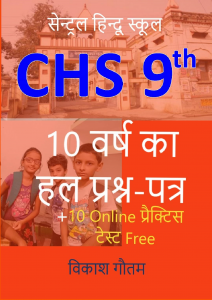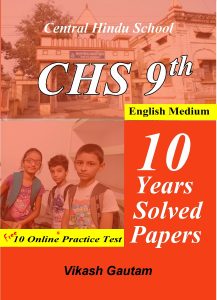Hello Dear little friends,
CHS Class 9 Practice Set, Sample Papers Model Question Papers Guess Papers 1/50 : You all are demanding for CHS Practice Sets, CHS Sample Papers and CHS Model Question Papers from many days on my Whatsapp.
here I am publishing 1/50 Practice sets for CHS Class 9th Entrance. as you know the question pattern for it or you can know it from above link. It contains 100 question from HINDI, English, Mathematics, Social Science/GS. Each Practice sets contains 100 MCQs for each subject of SET Syllabus 9th 🙂
CHS 9th Practice set 1/50
- Choose the industrial cities that grew rapidly in Britain in the nineteenth and twentieth centuries:
(a) Leeds and Manchester (b) Bristol and Manchester
(c) Carlisle and Leeds (d) Chester and Leeds
- Which were the three Presidency cities of Colonial India in late eighteenth century?
(a) Calcutta, Bombay and Madras (b) Calcutta, Bombay and Surat
(c) Bombay, Madras and Delhi (d) None of these
- What is Urbanization?
(a) Migration of population from rural to urban area
(b) Migration of people from urban to rural
(c) Migration of people from one country to another
(d) Migration of population from one state to another one
- 4. What is de-urbanization in the colonial context?
(a) The process by which many old towns, trading centers and ports emerged due to emergence of new cities.
(b) The process by which many old towns, trading centers and ports declined due to emergence of new cities.
(c) a and b both
(d) None of these
- Which of the following Indian cities which were de-urbanized during the nineteenth century?
- Machlipatnam,
- Surat
- Seringapatam
- Bombay
(a) i and ii (b) i, iv and ii
(c) i, ii and iii (d) i, ii, iii and iv
- In which year Delhi became the capital of British India?
(a) 1916 (b) 1913 (c) 1915 (d) 1911
- When was Shahjahanabad built?
(a) by ShahJahan in 1640 (b) by ShahJahan in 1638
(c) by ShahJahan in 1639 (d) None of these
- Before Delhi, which city was the capital of British India?
(a) Calcutta (b) Madras (c) Bombay (d) Agra
- What is Gulfaroshan?
(a) It was a festival of flowers celebrated annually in Patna during 16th century
(b) It was a festival of flowers celebrated annually in Delhi during 18thcentury
(c) It was a festival of flowers celebrated annually in Delhi during 11th century
(b) All of these
- Which period was referred as Delhi renaissance?
(a) 1857-1860 (b) 1860-1863
(c) 1865-1870 (d) 1830 – 1857
- In the 1870s, for what reasons the western walls of Shahjahanabad were broken?
(a) The walls were broken to establish the railway and to allow the city to expand beyond the walls.
(b) The walls were broken to establish textile and iron industries
(c) Both a and b (d) None of these
- On which hills was the city of New Delhi built on?
(a) Almoda hills (b) Vindhya hills
(c) Raisina Hill (d) None of these
- Name the architects who designed New Delhi and its buildings.
(a) Edward Lutyens and Herbert Baker (b) Herbert Baker and Harbar Lutyens
(c) Edward Lutyens and Harbar Lutyens (d) None of these
- How many years did it take to build the city of New Delhi?
(a) 15 years (b) 35 years (c) 20 years (d) 25 years
- Where was Bahadur Shah Zafar exiled to after 1857 revolt?
(a) Kashmir (b) south region
(c) Afghanistan (d) Burma
- Which of the following Defines Renaissance?
(a) It means rebirth of art and learning
(b) It is a term often used to describe a time when there is great creative activity
(c) a and b both (d) None of these
- When was Delhi College established?
(a) 1792 (b) 1793 (c) 1794 (d) 1792
- Kamal Khan Gakkhar was made a Mansabdar by:
(a) Babur (b) Akabar (c) Shanjahan (d) Jahangir
- The British conquest of Bengal began with the Battle of?
(a) Buxur (b) Tripoli (c) St. Tome (d) Plassey
- Haidar Ali and Tipu Sultan were the rulers of?
(a) Madhya province (b) Bengal (c) Awadh (d) Mysore
- Choose the correct option from the following:
Which part of the plant gets carbon dioxide from the air for photosynthesis. (a) root hair (b) stomata (c) leaf veins (d) sepals - Choose the right option. Green plants are:
a) herbivores
b) autotrophs
c) hetrotrophs
d) omnivores - The tiny pores present in the leaves of the plants for exchange of gases are
called ?
(a) Stomata
(b) Tracheae
(c) Chloroplast
(d) Spiracles - Rhizobium is an example of
(a) Symbiosis
(b) Parasites
(c) Insectivorous
(d) none of these - Which part of the plant gets carbon dioxide from the air for photosynthesis?
(a) root hair
(b) stomata
(c) leaf veins
(d) sepals - Iodine used to detect presence of starch. It gives starch
(a) red colour
(b) green colour
(c) blue-black colour
(d) colourless appearance - Amarbel (Cuscuta) is an example of:
(a) autotroph
(b) parasite
(c) saprotroph
(d) host - The plant which traps and feeds on insects is:
(a) cuscuta
(b) china rose
(c) pitcher plant
(d) rose - Green plants use which of the following to prepare food?
(a) Carnon DiOxide
(b) Sunlight
(c) Water
(d) All of these - : Which of the following statements is NOT true?
(a) Heterotrophs cannot prepare their own food.
(b) Dodder is an example of parasite.
(c) Saprophytes are green.
(d) Pulses and Beans are legumes - The main function of a leaf is:
(a) To prepare food
(b) To prevent disease
(c) To support the plant
(d) To give a proper shape - Examples of nutrients are:
a. Carbohydrates
b. Proteins
c. Fats
d. Minerals
e. All of these - Name the two modes of nutrition.
a. Autotrophic
b. Heterotrophic c. both d. none - What are the four things essential for photosynthesis.
a. Chlorophyll
b. Sunlight
c. Carbon Dioxide
d. Water e. all of these - The food prepared by plants is stored as _________
- In photosynthesis, the sunlight energy is captured by the pigment in plants called
________. - Plants which obtain food from dead and decaying matter are called __________.
- Amarbel is an example of __________.
- Basic functions which allow living organisms to live on earth are called _________.
- Name the cells that control the opening and closing of stomata is _________. options for Q.35 to 40 >> a. Guard cells b. starch (carbohydrates)
c. chlorophyll
d. saprophytes
e. parasite plant
f. life processes - MINOR (Q.41-51-Pick up the word or phrase from the choices which is close to opposite (antonym) to word
asked.
(a) heavy
(b) tall
(c) major
(d) big - NICE
(a) decent
(b) unpleasant
(c) sorry
(d) polite - SHALLOW
(a) high
(b) hidden
(c) hollow
(d) deep - CONFLICT
(a) confer
(b) collide
(c) converge
(d) contrast - CONTENT
(a) exhausted
(b) peaceful
(c) dissatisfied
(d) excited - FIERCE
(a) gentle
(b) violent
(c) inactive
(d) careful - ABOLISH
(a) revoke
(b) repair
(c) supress
(d) terminate - SOLID
(a) dirty
(b) dangerous
(c) strong
(d) soft - ARTIFICIAL
(a) dummy
(b) earthy
(c) spurious
(d) synthetic - ANXIETY
(a) calmness
(b) leisure
(c) scare
(d) apprehension - TRANSPARENT
(a) limpid
(b) coloured
(c) opaque
(d) forthcoming
Answer Key
1-20 will updated later
21. (b) stomata 22. (b) Autotrophs Note: Here Green plants are mentioned. Non Plants (both green +
non-green) together are autotrophs and hetrotrophs.
23: (a) Stomata
24: (a) Symbiosis
25: (b) stomata
26: (c) blue-black colour
27: (b) parasite
28: (c) pitcher plant
29: (d) All of these
30: (c) Saprophytes are green.
31: (a) To prepare food
32: (e) All of these
33: (C) both
34: (e) all of these
35: b. starch (carbohydrates)
36: c. chlorophyll
37: d. saprophytes
38: e. parasite plant
39: f. life processes
40: a. Guard cells
41: (c) major
42: (b) unpleasant
43: (d) deep
44: (a) confer
45: (b) peaceful
46: (a) gentle
47: (b) repair
48: (d) soft
49: (b) earthy
50: (a) calmness
51: (c) opaque
- Next :- Practice Set- 2




Leave a Reply
You must be logged in to post a comment.